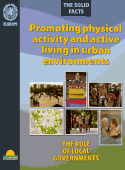Promoting physical activity and active living in urban environments. The role of local governments. The solid facts.

Download
By Peggy Edwards and Agis Tsouros
2006, ix + 56 pages
ISBN 92 890 2181 0
This publication is only available online.
People's participation in physical activity is influenced by the built, natural and social environments in which people live as well as by personal factors such as sex, age, ability, time and motivation. The way people organize cities, design the urban environment and provide access to the natural environment can be an encouragement or a barrier to physical activity and active living. Other barriers exist in the social environments within which people work, learn, play and live.
Physical activity is an essential component of any strategy that aims to address the problems of sedentary living and obesity among children and adults. Active living contributes to individual physical and mental health but also to social cohesion and community well-being. Opportunities for being physically active are not limited to sports and organized recreation; opportunities exist everywhere - where people live and work, in neighbourhoods and in educational and health establishments.
The Healthy Cities and urban governance programme of the WHO Regional Office for Europe has focused on how local governments can implement healthy urban planning to generate environments that promote opportunities for physical activity and active living.
This publication presents the best available evidence on physical activity in the urban environment and makes suggestions for policy and practice based on that evidence. Mayors and other elected city officials can use this information to address the needs and contributions of all citizens in different settings of everyday life with the aims of ensuring equitable and comprehensive efforts to promote physical activity and active living.



